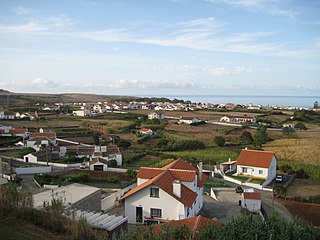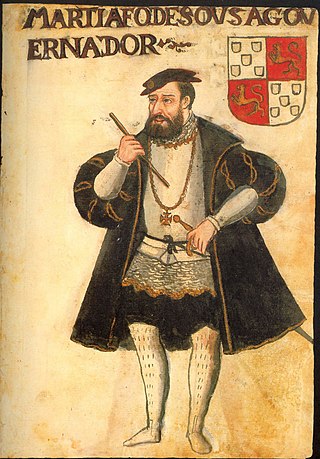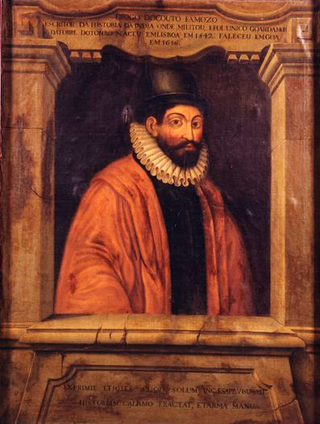
Praia da Vitória is a municipality in the Portuguese archipelago of the Azores. With a population of 21,035,the second largest administrative authority on the island of Terceira,it covers an area of 162.29 square kilometres (62.66 sq mi),that extends from the northern coast halfway into the interior.

Vila do Porto is the single municipality,the name of the main town and one of the civil parishes on the island of Santa Maria,in the Portuguese archipelago of Azores. Its nearest neighbor,administratively,is the municipality of Povoação on the southern coast of São Miguel,and it is physically southwest of the islets of the Formigas. The population in 2021 was 5,408,in an area of 96.89 km2 (37.41 sq mi).

Santa Cruz das Flores is a municipality situated in the north half of the island of Flores,in the Portuguese archipelago of the Azores. Situated in the sparsely populated Western Group,the population in 2021 was 2,020 inhabitants in an area that covers approximately 70.91 square kilometres (27.38 sq mi),bordering the southern municipality of Lajes das Flores.

Martim Afonso de Sousa was a Portuguese fidalgo,explorer and colonial administrator.

Francisco Barreto was a Portuguese soldier and explorer. An officer in Morocco during his early life,Barreto sailed to Portuguese India and was eventually appointed viceroy of the colony. After his return to Lisbon,he was tasked with an expedition to southeast Africa in search of legendary gold mines. Barreto died in what is now Mozambique,having never reached the mines.
Count of Santa Cruz was a Portuguese title of nobility created by a royal decree of King Philip II of Portugal,also known as Philip III of Spain,dated from October 3,1593,and granted to Francisco de Mascarenhas (1530-1608),nephew of Dom Pedro de Mascarenhas,6th Viceroy of Portuguese India.
The Count of Vila da Horta was a title created by Philip I of Portugal in 1585 in favor of Francisco de Mascarenhas.

Count of Atouguia was a Portuguese title of nobility created by a royal decree,dated from 17 December 1448,by King Afonso V of Portugal,and granted to D. Álvaro Gonçalves de Ataíde.
The Prior of Crato,was the traditional title given to the head of the Order of the Knights of St. John of Jerusalem (Hospitaller) in Portugal. It is a reference to the domains of the order around Crato,Portugal.

Diogo do Couto was a Portuguese historian.

The Forty Conspirators,were a Portuguese nationalist group during the Iberian Union. The Conspirators were composed of forty men of the Portuguese nobility,and many clergy and soldiers. Their goal was to depose the House of Habsburg king,Philip III.
The Captaincies of the Azores were the socio-political and administrative territorial divisions used to settle and govern the overseas lands of the Azores by the Kingdom of Portugal. These territories,a segment of the Captaincies of the Portuguese Empire,which usually conformed to the individual islands,allowing the stewardship of the King through the Donatary and Captaincy system.
Pedro Soares de Sousa,also known as Pero Soares de Sousa exercised the role of the third Donatary-Captain for the island of Santa Maria,between 1571 and 1573,as well as between 1576 and 1580 and succeeded by Jerónimo Coutinho. He should not be confused with his descendant and seventh Donatary-Captain of Santa Maria,who in a testament dated 12 February 1634,referred to his 1616 ascendancy to the stewardship of Santa Maria.

The Captaincy General of the Azores was a politico-administrative structure of governance imposed in the Azores on 2 August 1766,with its seat in Angra. It remained the de facto system of governance for 65 years,until it was abolished on 4 June 1832 by D. Peter IV,but by 1828 its de jure status had made it nonoperational,owing to the revolutionary movements that lead to the Liberal Wars. The creation of the Captaincy-General was part of the Pombaline reforms to the Portuguese administration,during the reign of Joseph I,under the initiatives of Sebastião Joséde Carvalho e Melo,1st Marquis of Pombal,then prime minister. A Captaincy-General operated from the Palace of the Captains-General,under the direction of the titular Captain-General,who operated as the Governor of the Azores,with additional jurisdiction on every island of the Azorean archipelago. The Captaincy-General was succeeded by the Province of the Azores,an ephemeral administrative structure that was collapse in the immediate years.
The Church of Nossa Senhora do Pilar is a 17th-century church located in the civil parish of Cedros in the municipality of Santa Cruz das Flores,in the Portuguese island of Flores,in the archipelago of the Azores.
Ataíde is a Portuguese surname. Notable people with the surname include:

Dom Martinho de Ataíde,2nd Count of Atouguia,was a 15th-century Portuguese nobleman and diplomat. In 1455,he was granted the lordship of the Canary Islands,by donation from King Henry IV of Castile,which he later sold to the Count of Viana.

D. Luís de Ataíde,1st Marquess of Santarém and 3rd Count of Atouguia,was a Portuguese nobleman,military commander and statesman of the 16th century,who stood out for his military feats in the Portuguese State of India. He served as Viceroy of India for two non-subsequent terms.

Ataíde is the name of a noble family from the Kingdom of Portugal,many of whose members played important roles in the course of the Portuguese overseas exploration and expansion and in the internal and foreign policies of Portugal and its empire.

D. Jerónimo de Ataíde,6th Count of Atouguia was a Portuguese nobleman and colonial administrator,Governor-General of Brazil from 1654 to 1657.











